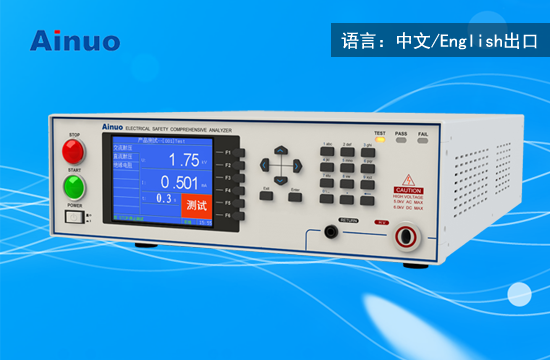Hipot Tester
Hipot tester, also known as dielectric strength testers, use to perform the test of applying a predetermined Dc or Ac high voltage between both the live and non-live parts of an electric appliance to establish the hipot of the insulation system. Electrical appliances in long-term use must withstand not only the effect of the rated voltage level but also the effect of an overvoltage greater than the authorised working voltage for a brief period during operation. The overvoltage value can be many times the rated operating voltage value.
The inner core of electrical insulating materials will alter as a result of the effect of these voltages. When the voltage spikes intensity exceeds a particular level, the insulation of the material will fail. The electrical equipment will not function correctly, and the operator may receive an electric shock, putting his or her safety at risk. ground resistance, AC/DC hipot, leakage current, insulation resistance, and other electrical safety test indications are the most common.
What is Hipot Testing?
The fundamental procedures for electrical safety assessment on a manufacturing line are hipot testing and, when appropriate, earth bond testing.
The hipot test, which is an abbreviation for the High Potential Test, is a direct extension of a high voltage to an item under test. To emphasize the dielectric characteristics of the product under test, the test voltage is often significantly greater than the normal operating voltage.
The test intends to detect that the gaps or certifications between conductive parts and earth or the product chassis are adequate and that degradation, such as pinholes, cracks in insulation, and other protection devices, have not resulted from manufacturing processes or wear and tear, for example, a live conductor is not crushing between the mating parts of the chassis, having caused it to become live when switched on.
When the insulation fails, current flows from across sample points of the Hipot tester; this current flow is generally referred to as leakage. If the leakage current is too large, the object under the test to consider dangerous, and the test fails.
Hipot Tester Basic Principle:
The hipot test measures the capacity of various electrical equipment, insulating materials, and insulating structures to withstand high temperatures. The procedure of delivering high voltage to insulating structures or insulating materials are hipot test. It works on the assumption of not degrading the efficiency of insulating materials. In general, the hipot test uses to determine if the insulation can survive the working voltage or voltage unbalance, and then to determine whether the insulation efficiency of the product gear fulfils the safety regulations.
The main premise of the hipot test is to deliver a greater voltage than normal operating conditions to the insulation of the system under test for a certain amount of time. If the insulation between them is adequate, the voltage supplied to it will result in only a little leakage current. If the leaking current of an insulator in a system under test stays within a specific range for a set duration, it is possible to conclude that the gadget under test may run safely under standard operating circumstances.
When performing the hipot test, the measuring criteria for the tested goods with varied technical requirements are also diverse. The hipot test evaluates the leaking current value between both the live wire and the chassis for general tested equipment. The basic guideline is that the normal voltage for testing is twice the operational voltage of the tested device + 1000V. Some products’ test voltages may be greater than the specified value. Following the test, the test voltage shall gradually decrease to zero within the time indicated.
Hipot Tester Structure
Set-up Part
The voltage-controlling transformer, step-up transformer, power connection, and cut-off switch comprise the pressure-increasing section. Turning on or off the switch connects the voltage to the voltage-regulating transformer and the output of the regulatory transformer link to the step-up transformer. Users need to change the voltage regulator to manage the step-up transformer’s output voltage.
Controlling Part
The control section makes up of current sampling, a timer circuit, and an alert circuit. When the control component gets a start signal, the instrument turns on the power supply to the step-up part. Once the current of the circuit under evaluation exceeds the predetermined value, an audible and visual alert produces, and the power supply to the step-up circuit turns off. When the reboot or time-out signal obtains, the surge circuit power supply turns off.
Circuit Display
The display indicates the step-up transformer’s output voltage, the present value of the current sensing part, and the time circuit’s countdown.
Conclusion
The test is to detect insulation failures, spikes, and unprotected circuits in the wired network. Hipot testing is often performed on live wire bundles, cables, circuit boards, and other components. You can get the Hipot Tester from a Hipot Tester distributor like Technical Products which is a Hipot Tester distributor in India.


